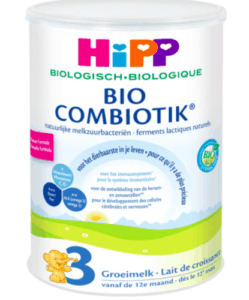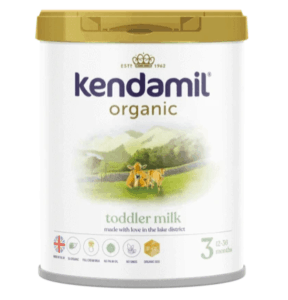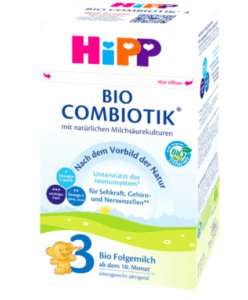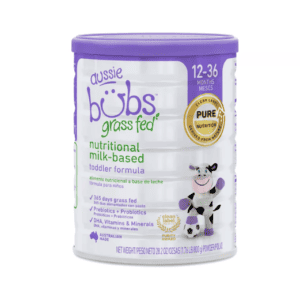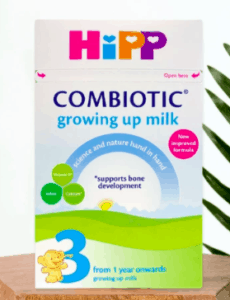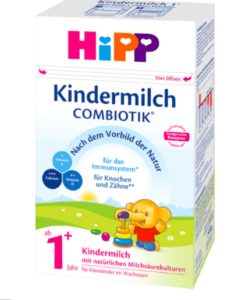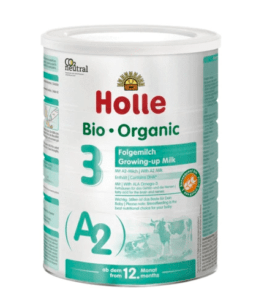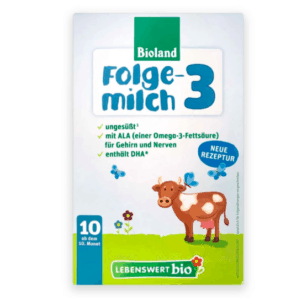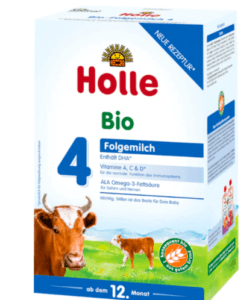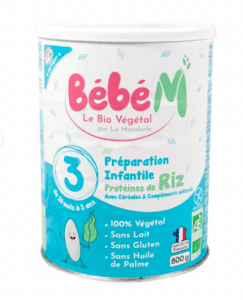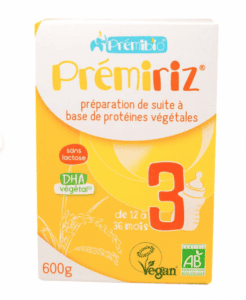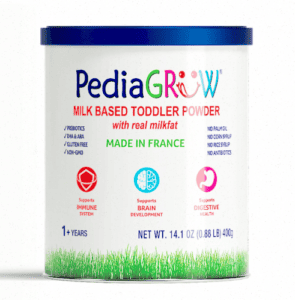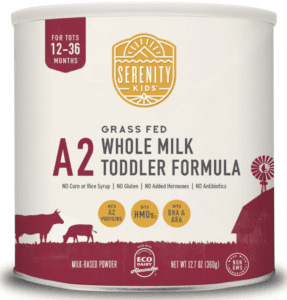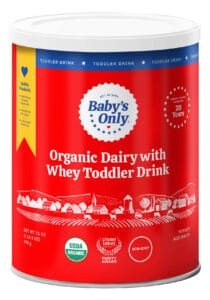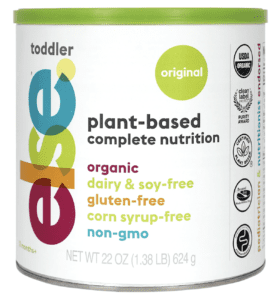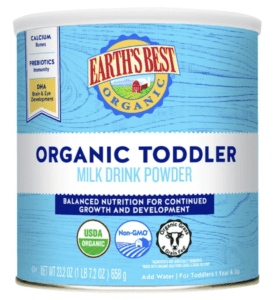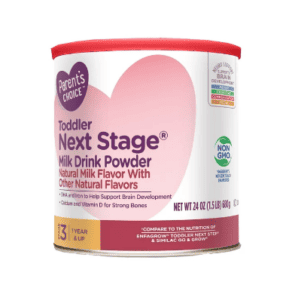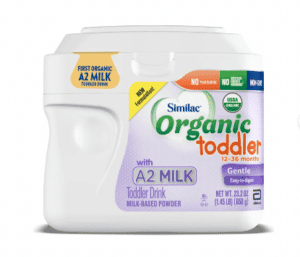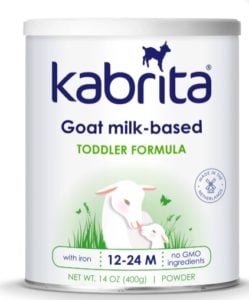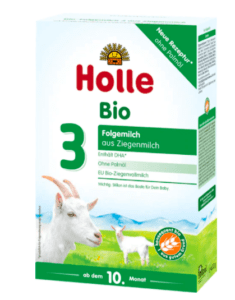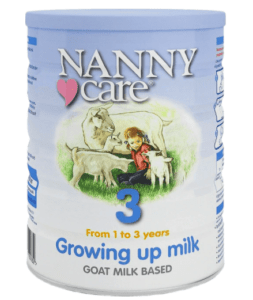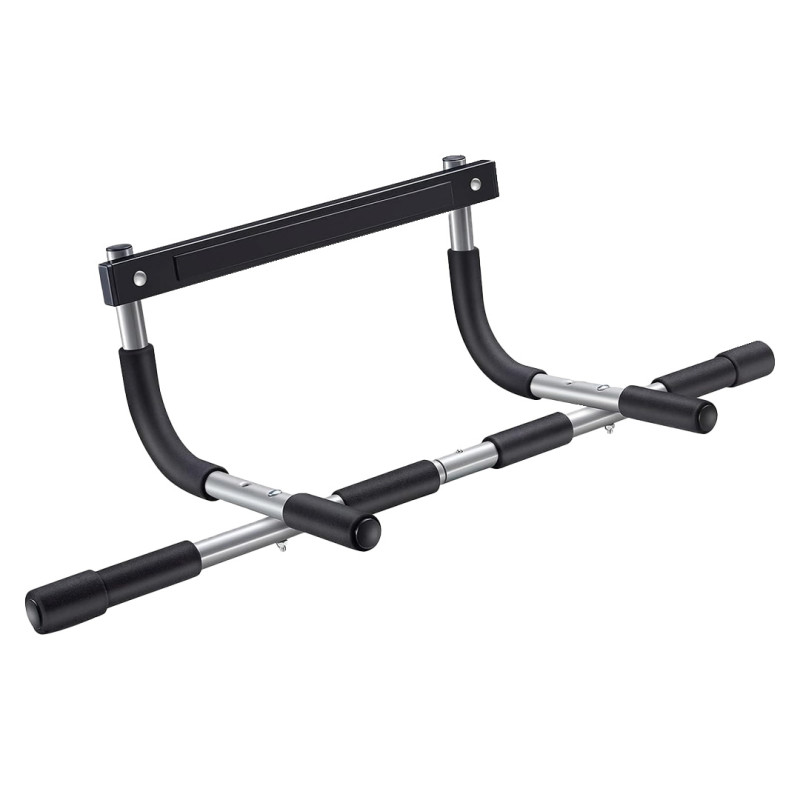Health
Best Toddler Formulas (2024 Guide)

This post may contain affiliate links. As an Amazon Associate, I earn from qualifying purchases. Please read my disclosure.
If your child is older than 12 months, you may be wondering whether or not you should continue giving them formula. In this post, I’ll answer all of your questions about whether or not you should continue formula and provide you with a list of the best toddler formulas on the market today!
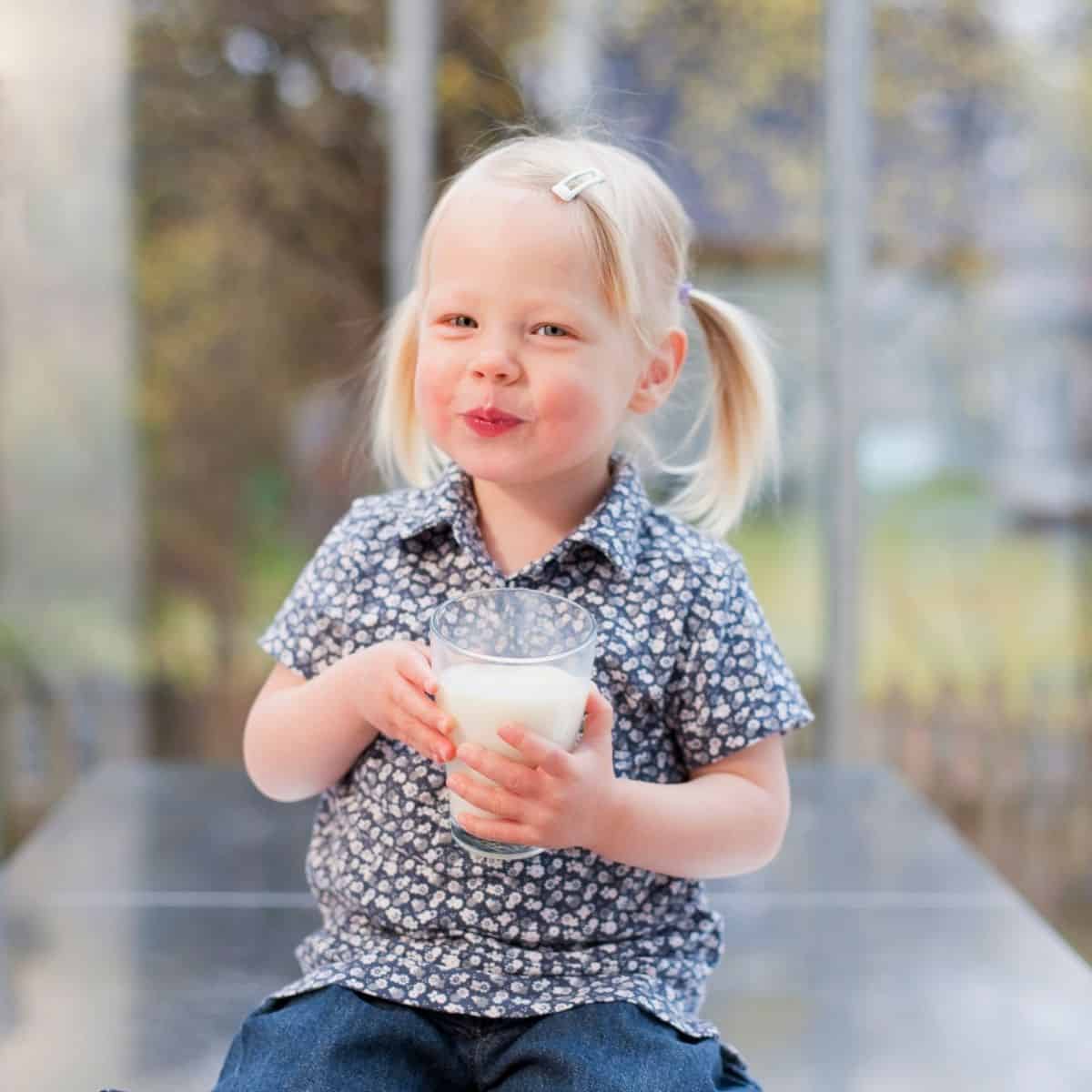

When your child is an infant, they need breast milk or formula to grow and thrive. As they grow older, solids are introduced, but breast milk and formula continue to be the main source of nutrition.
However, after the age of 12 months, many parents wean their child from the breast or formula. But as your child grows, you may be wondering if you should continue with formula, or possibly even switch to a toddler formula.
In this post, I’ll answer all of your formula questions so that you can decide if continuing with formula or switching to a toddler formula or whole milk is a good idea for your child. This post will also help you find the best toddler formula – with detailed guidelines on what to look for and what to avoid!
A Disclaimer And Our Methodology
As a board certified health coach and certified nutritionist, I support products and ingredients that are rooted in science and are evidence-based. Using my background in nutrition, along with extensive research (see below for details), consultations with experts, and my own personal experience giving my two kids formula, I was able to arrive at this list of the best formula for toddlers in this guide. This post has also been medically reviewed and fact checked by Christina Badaracco, MPH, RDN, LDN (see my about page for more info about Christina).
My toddler formula recommendations are based on:
- Over 100 hours of extensive research
- Speaking with hundreds of parents on what has worked for their children (along with personal experience with my own two kids)
- Reviewing the manufacturer’s claims and ingredients list of all of the current different toddler formula brands
- Speaking with doctors, pediatricians, dieticians and other medical experts
- Reviewing countless articles and peer-reviewed studies
Though I may receive a commission (at no extra expense to you) if you purchase through some of the affiliate links provided, I only recommend products that I’ve researched, evaluated, consulted experts on, and would feel comfortable giving to my own two children. As always, I only share products that are the highest quality and that can help you and your family the most. By purchasing any of these products from the links below, you help keep this blog running, so thanks for your support!
Keep in mind that every baby and situation is different, so when it comes to choosing a toddler formula, please consult with your pediatrician first before starting on or switching to a different toddler formula. My recommendations are not a substitute for professional medical advice, diagnosis, or treatment.
What Is Toddler Formula?
Toddler formula is for young children between the ages of 9 months and 3 years. It’s meant as a transition between infant formula and whole milk. Since most babies are eating solids by 6–9 months, most toddler formula is created to be a supplemental nutrition source rather than a complete one, unlike infant formula.
Toddler milks or formulas are made with many of the same ingredients as infant formula. However, as I’ve explained when recommending the best organic baby formula, many ingredients in toddler formulas (such as added sugars, thickeners/stabilizers, and synthetic nutrients) are not beneficial for your child.
It is also important to note that not all toddler formulas are FDA-regulated for their nutritional content. This means that most of the varieties on the market have more sodium, fat, and sugar than infant formula. Furthermore, because the FDA does not set consistent nutritional guidelines for these products, many of the toddler formulas vary in their nutritional profiles (source).
However, not all toddler formulas are bad! There are actually high-quality, organic toddler formulas out there to choose from. Depending on your child’s needs and following the guidance of your child’s pediatrician, using a toddler formula may be a good choice – especially if you choose a high-quality formula that has additional vitamins, minerals, and other key nutrients.
When Is Toddler Formula Recommended By Your Doctor?
Your pediatrician may recommend toddler formula for any of the following reasons:
- A kidney condition (e.g. chronic kidney disease) that makes your child unable to digest cow’s milk
- Iron-deficiency anemia
- Developmental delays
- Malnourishment
- Growth concerns or other nutrition concerns
- Medical conditions
But remember, do not start toddler formula without the recommendation of your pediatrician.
Do Babies Need Formula After 12 Months?
According to the American Academy of Pediatrics (AAP) and the American Academy of Family Physicians, pediatricians recommend that healthy toddlers between the ages of 12–24 months should switch to whole dairy milk and consume 16–24 ounces a day (source).
Before the age of 12 months, giving your child dairy as a primary nutrition source is discouraged (source). This is because babies’ kidneys are not yet mature enough to handle the proteins and minerals in cow’s milk. Cow’s milk also doesn’t have the complete nutrition for infants to subsist on. For these reasons, the main food source during your baby’s first year should be breast milk or infant formula.
Therefore, it is not necessary to continue with infant formula after the age of 12 months. However, this number is not set in stone, and babies and families will vary a bit as to when they make the transition to whole milk. For example, if your child was born prematurely, your pediatrician is concerned about growth or weight, or your child is a super picky eater, continuing formula may be the right choice. Always consult your pediatrician for guidance on whether your little one should switch to toddler formula and when to do so.
After 12 months, your child should be getting a substantial portion of their nutrition from healthy baby superfoods such as avocados, blueberries, spinach, butternut squash, and other foods that can be introduced before 1 year of age (e.g., soft meats, fish, beans, yogurt, etc.) (Source 1, Source 2).
Note: introducing nuts (as well as peanuts) in the form of powder, puffs, or nut butter mixed into a puree before 12 months is also often recommended now to prevent development of allergies and provides beneficial nutrients (source).
From age 1 and beyond kids can eat more dairy, and continue to eat animal protein sources (if applicable to their diet), beans, whole grains, nuts and seeds, and a variety of other foods as well.
Related: Easy Homemade Baby Food Recipes
A note about breastfeeding after 12 months: if you are breastfeeding, you can continue doing so until you and your child are ready to wean. Your breast milk composition will naturally change as your nursing baby grows, adapting to their changing nutritional needs (source).
Toddler Formula Vs. Milk
The best organic toddler formulas have added vitamins, minerals, and other nutrients, above and beyond what whole milk provides. This is usually not necessary for most children who are getting an otherwise balanced diet since a lot of those vitamins can also come from solid foods as well as milk.
Whole milk is meant to provide your child with needed calories, fat, protein, and minerals—but won’t be as nutrient-packed as formula, which is fortified with additional nutrients for children who need it.
According to the AAP, there is no evidence that toddler formula is any better than regular, organic, whole milk (source). However, in some of the cases listed above where your child may not be getting a complete and healthy diet, some children’s toddler formulas could be a better option.
How Frequently Should I Give My Child Toddler Formula?
If you choose to give your child toddler formula, it is recommended that they consume somewhere between 12–24 ounces per day, depending on the brand and the feeding guidelines recommended to you by your doctor.
As your child grows past the age of 12 months, they will gradually shift to getting most of their nutrition from a balanced diet of vegetables, fruits, whole grains, and healthy protein sources. For this reason, the bulk of their nutrition should come from nutritious solid foods.
Related: Baby-Led Weaning Foods & Guide
What To Look For In Toddler Formula
- Organic: This ensures that you are buying a formula that is made without pesticides, GMOs, hormones, or artificial and synthetic ingredients. If you can’t go with an organic formula, I recommend choosing one that is at least non-GMO.
- Whey-to-Casein Ratio: A whey-to-casein ratio of 60:40 most closely resembles mature breast milk, making the formula easier for little ones to digest.
- Grass-Fed: Organic formulas use cow or goat milk, so look for ones that are grass-fed if possible. This type of milk is higher in omega-3 fats (source), making it a better source of natural DHA (source).
- No Added Sugars: Added sweeteners include ingredients such as corn syrup, maltodextrin, sugar, brown rice syrup, corn sugars, and syrup solids. Many of these sugars are processed and don’t add nutritional value to the formula. Instead, lactose, which is the naturally occurring sugar in milk, should be the only carbohydrate source used (the alternative carbohydrate sources would be added sugars as mentioned here).
- Prebiotics And Probiotics: Studies show that prebiotics and probiotics help to develop a healthy immune system (source), making them an important component to consider when shopping for toddler formulas. More formulas contain prebiotics than they do probiotics. If you choose a formula that lacks probiotics, I recommend supplementing your child’s diet with probiotic-rich foods such as yogurt and kefir.
- DHA and ARA: These are two fatty acids that facilitate healthy eye and brain development (source). DHA is an omega-3 and ARA is an omega-6. If possible, look for DHA and ARA that are extracted without using hexane. Hexane is a toxic substance and though the chemical doesn’t remain in the final oil product (source), cleaner extraction methods such as cold presses that don’t require any toxic chemicals can be a safer alternative and provide more peace of mind for parents.
- Essential Vitamins and Minerals: Vitamin D, B vitamins, vitamins C, E, and A; and minerals such as phosphorus, iron, and magnesium play a role in healthy development. All of the different formulas on this list contain these essential vitamins and minerals.
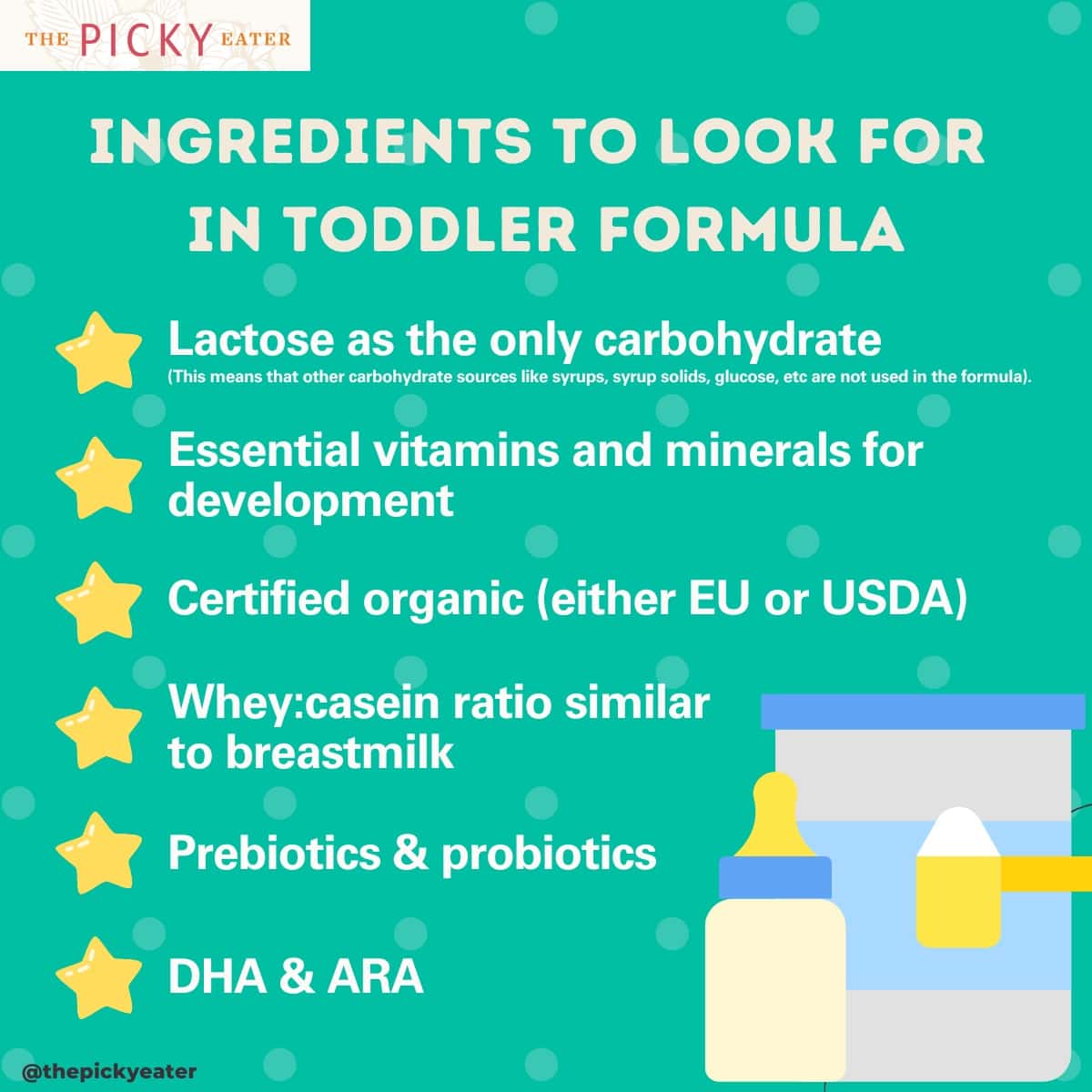

Ingredients To Avoid In Toddler Formula
- Added Sugar Or Syrup Solids: Some formulas use sugar, glucose, corn syrup, syrup solids (or other added sugars) as a carbohydrate source, but these are added sugars and can contribute to longer term health issues (Source). Syrups or syrup solids are less ideal than the better carbohydrate source – lactose – which is a natural sugar found in milk.
- Synthetic DHA and ARA: DHA and ARA are naturally found in breast milk. When added to a formula, they sometimes come from algae and fungus, respectively, and are often extracted using hexane. DHA and ARA that are extracted using a different process, such as cold pressing, are preferred. It may not be possible to tell based on package labels whether the DHA and ARA are synthetic or natural, so you can contact the formula company to verify.
- Heavy Metals: Some formulas have been found to have high levels of heavy metals, but you won’t be able to find this information just by looking at the ingredients list. Instead, you’ll have to do a little digging to see if your formula has been tested for heavy metals or not. I recommend looking at the Clean Label Project’s database and the EWG database to find this information (source 1, source 2, source 3).
- GMOs: Look for formulas that are certified non-GMO. If you buy an organic formula, it is automatically non-GMO. GMOs are concerning because some of these genetically engineered crops are designed to be resistant to the carcinogenic herbicide Round-Up. (Source).
- Carrageenan: This ingredient has been banned in Europe but is still used as a thickening agent in some formulas in the US. Carrageenan is known to cause inflammation in the intestines (source) and is therefore a good ingredient to avoid.
- Soy or Soy-Based Products: Too much soy given to infants may lead to health complications in the future, making it a good ingredient to avoid if possible (source).
- Palm Oil: This ingredient is not environmentally friendly and can cause digestive issues and calcium absorption issues in some babies (source). Palm oil is a common ingredient in US formulas, but it isn’t commonly found in European formulas. Note: If you are purchasing a US-manufactured formula and have to choose between palm oil and soy oil, I would recommend going with palm oil, because soy can be even more problematic in children.
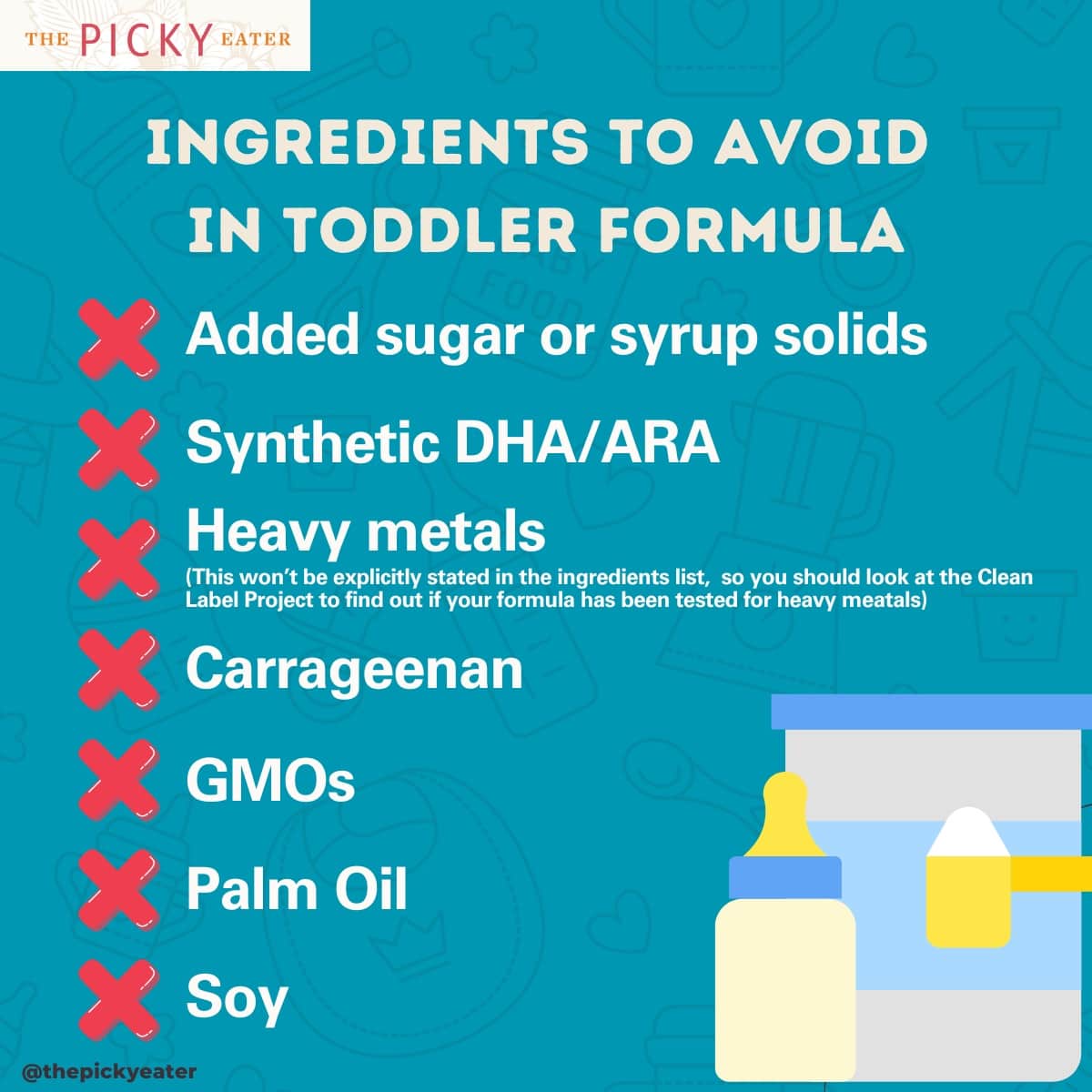

13 Best Toddler Formulas: European & International Brands
International and European formulas tend to be the best bet for clean and organic formulas because they are made according to the strict European Union regulations, though there are more and more quality American formula brands entering the market. For this reason, I am splitting the toddler formula review into the top European and International and the top United States toddler formula offerings currently available.
Without further ado, my top recommendations for international formulas:
Hipp Dutch Stage 3
Why I love it: This is my #1 pick for the best toddler milk. It is made with organic and non-GMO ingredients and is free from preservatives, steroids, pesticides, hormones, and other chemicals. It also has added probiotics and prebiotics; DHA; iron; vitamins A, C, & D; B vitamins such as folic acid and vitamin B12, and more.
Since this formula is suitable for 12 months and older, it is lower in lactose content than HiPP’s infant formulas, but is still made without any added sugar, syrups, or maltodextrin. This formula is on the more expensive side, but has great flavor and is easy to mix. It is also only available for purchase through European formula subscription services (such as MilkyBox).
Price: Costs $48.99 for 800g (28.22oz) of formula.
No maltodextrin or added starch
Free of pesticides, hormones, steroids, and preservatives
Contains probiotics similarly found in breast milk
Contains prebiotics (GOS modeled on breast milk)
DHA/ARA are extracted using hexane, but no hexane is detectable in the finished formula
Contains palm oil (but is organic palm oil from sustainable cultivation)
Kendamil Organic Stage 3
Why I love it: Kendamil is one of my preferred European formula brands. This British formula company is family-owned and is based in Kendal’s Lake District. Kendamil is made with whole milk from British farmers, meaning that it is lower in added vegetable oils. Because of this, the formula is proudly soy-free and contains no palm oil. It follows European Union standards, which are higher than US standards, making it free of corn syrup and added sugar.
Kendamil’s organic toddler formula is made with plant-based DHA, making it vegetarian-friendly while supporting muscle, eye, and brain development. It is high in minerals such as iron and vitamins A, C, E, and D. The only reason it’s ranked slightly lower than HiPP Dutch Stage 3 is its higher price tag.
Previous to the United States formula shortage, Kendamil was only available through European subscription services. Their toddler formula is now available for purchase at Target, but is not organic.
Price: $55.99 for a single 800g (28.22oz) can of formula. Buy in bulk for as low as $49.99 per 800g can.
Certified to European standards
Contains DHA and ARA from plant-based sources (not hexane-extracted)
Vegetarian-friendly (no fish oil)
No added sugar or corn syrup
No palm oil (uses coconut oil instead)
No maltodextrin or added starch
More expensive than HiPP Dutch
HiPP Germany Stage 3
Why I love it: This toddler formula is another fantastic option from HiPP, one of my favorite European formula brands. This formula is made in Germany with high-quality organic milk from grass-fed cows. It is made according to European organic formula standards, making it free of synthetic preservatives, GMOs, and more.
HiPP Germany Stage 3 contains prebiotics, probiotics, DHA and ALA, and it contains 40 times more iron than cow’s milk to help your toddler meet their daily requirement of this essential nutrient. This toddler milk also contains lactic acid that was originally obtained from breast milk to support your little one’s gut health development. It is suitable from the 10th month onwards, and contains vitamins A, C, and D.
Price: Costs $37.99 for 600 grams of formula (equivalent to $50.65 for 800 grams of formula). Buy in bulk for as low as $26.40/box.
Contains lactic acid (obtained from breast milk)
Lactose is main carbohydrate
Less convenient container (box instead of canister)
On the pricier side (but bulk discounts available)
Contains palm oil (but is organic palm oil from sustainable cultivation)
Aussie Bubs Grass Fed Nutritional Milk-Based Toddler Formula
Why I love it: Bubs is a newer addition to the formula market but produces one of the best organic milk formulas for toddlers. This company was founded in 2005 in Australia and is based upon high-quality principles. This whole cow’s milk formula is made with organic milk from cows who grass feed in open pastures for 365 days of the year.
Containing prebiotics, probiotics, DHA, ARA, and essential vitamins, this formula is a great addition to your child’s diet if a pediatrician recommends a toddler formula for your little one. This powdered formula is meant for babies aged 12–36 months and received the Clean Label Project Purity Award, making it free of unhealthy ingredients, pesticides, pathogens, and more.
Cost: $28.99 for a 800g can of formula.
No maltodextrin or starch
No added sugar or corn syrup
Received the Clean Label Purity Award
Affordable compared to other international formula options
Available for purchase at Amazon, Target, and Walmart
HiPP UK Stage 3
Why I love it:HiPP UK is another one of the best formulas for one-year-olds. It is very similar to the HiPP Dutch Stage 3, with a few exceptions. It is made according to EU standards and is organic, non-GMO, and free of starch, maltodextrin, sugar, and more. Like HiPP Dutch, it is made with organic skimmed milk, lactose, vegetable oils, vitamins, and also contains prebiotics and DHA. Additionally, since this toddler formula contains docosahexaenoic acid (DHA) from fish oil (as does HiPP Dutch), it is not a vegetarian-friendly formula.
The main difference between HiPP UK Stage 3 and HiPP Dutch Stage 3 is that the UK version does not contain added probiotics. It is also about 6 dollars less per container of formula.
Price: Costs $42.99 for 600 grams of formula (equivalent of $57.32 for 800 grams of formula). Buy in bulk for as low as $36.99/box.
No maltodextrin or added starch
Contains DHA/ARA (from fish oil)
Lactose is the main carbohydrate
Comes in less convenient box container
On the pricier side (but not as pricey as HiPP Dutch Stage 3)
Contains palm oil (but is organic palm oil from sustainable cultivation)
HiPP Stage 4 (HiPP Kindermilch)
Why I love it: HiPP Stage 4 is a fantastic organic follow-on formula for picky eaters or for little ones who don’t otherwise consume all of the nutrients necessary in a toddler’s diet. This formula contains the nutrition content needed for healthy growth: skimmed milk, lactose, iron, vitamins D and A, B vitamins, probiotics, and more. This milk powder for toddlers also contains lactic acid cultures derived from real breast milk, which encourage gentler digestion for your toddler as their digestive flora change from eating solid foods.
This is an ideal formula to use if you plan to supplement with formula well into the toddler years as it is made specifically for drinking from a cup vs. a bottle.
Price: Costs $40.99 for 600 grams of formula (equivalent to $54.65 for 800 grams of formula). Buy in bulk for as low as $33.99/box. For families who intend to formula feed beyond the age of 2, there is also a Follow On Stage of Kindermilch for kids aged 2+.
Formulated for toddlers aged 12-36 months
No maltodextrin or starch
Contains probiotics similarly found in breast milk
Contains prebiotics (GOS; modeled on breastmilk)
Contains DHA and ARA (arachidonic acid)
Less convenient container comes in box rather than canister
Contains palm oil (but is organic palm oil from sustainable cultivation)
Holle A2 Milk Stage 3
Why I love it:This toddler powder milk is made from high quality organic A2 milk, or milk that is comprised of the A2 milk protein that can be easier to digest than the more commonly found A1 milk protein (source 1, source 2). It’s almost impossible to find organic A2 milk at the grocery store—so if your toddler needs A2 milk, this could be one of the best options for them. This toddler milk is great for children aged 10 months and older.
Otherwise, this milk is made with organic ingredients and is biodynamic and Demeter certified. Demeter is the largest international certification organization for biodynamic agriculture (source), helping to make this one of the safest toddler formulas on the market today. In addition to this, this growing-up milk contains DHA and ALA for healthy eye and cognitive development, essential vitamins, iron, and more.
Price: It is $31.99 for a 400g box of formula (or $63.98 for 800g). Buy in bulk for as low as $25.99/box.
Organic, biodynamic, and Demeter certified
Made from skim milk from cows with A2 beta-casein protein
Much more expensive than the other formulas on this list
Contains palm oil (but is organic palm oil from sustainable cultivation)
Lebenswert Stage 3
Why I love it: This toddler formula is another great option from one of my favorite European formula brands, Lebenswert. Made in Germany using organic cow’s milk, this easy-to-digest formula is great for babies 10 months of age and older.
Though this formula does have sufficient essential vitamins, minerals, macronutrients, and DHA for your baby’s development, it doesn’t contain probiotics or prebiotics and also has added maltodextrin, an often processed starch used for thickening. The formula is free of artificial ingredients, chemical additives, gluten, preservatives, soy, and GMO ingredients, however.
Price: Costs $27.99 for 475 grams of formula (equivalent to $48.82 for 800 grams of formula). Buy in bulk for as low as $19.26/box.
Contains DHA (from fish oil)
No artificial or chemical additives
Holle Bio Stage 3
Why I love it:There’s not many reasons not to love Holle Bio Stage 3! One look at the product label and you will see that this is a great formula for one-year-olds because it provides the vitamins, minerals, and other nutrients for your baby’s overall health. Furthermore, this formula is organic and Demeter certified, meaning that it is produced with only the highest quality ingredients.
One of the pros of Holle Bio is that it is one of the most affordable European formula brands on the market. Buy in bulk and you will save even more money while feeling good about what you are feeding to your child!
Price: Costs $34.99 for 600 grams of formula (equivalent to $46.65 for 800 grams of formula). Buy in bulk for as low as $28.99/box.
Bioland and Demeter certified
The most affordable European formula option!
Contains palm oil (but is sustainably sourced)
Holle Bio Stage 4
Why I love it: Holle Bio Stage 4 is the final stage of the Holle Bio line. It is meant for children aged 12 to 24 months and is formulated to complement a weaning or solid diet and can be used as a whole milk substitution. It may be fed in a bottle or incorporated into cereal. This formula is on my list of top picks because it is high in protein, iron, calcium, and other essential vitamins and minerals while being organic, Demeter certified, easy to digest, and made with no added sugar.
Like Holle Bio’s other offerings, this toddler milk is one of the most affordable European formulas while not compromising on quality, nutrition, or flavor.
Cost: $34.99 for 600 grams of formula (equivalent to $46.65 for 800 grams of formula). Buy in bulk for as low as $28.99/box.
Organic and Demeter certified
Can be used up to 2 years of age
Maltodextrin and added starch
Contains palm oil (but is sustainably sourced)
Bébé M Organic Vegan Stage 3
Why I Love it: If you are looking for a toddler formula that is made with plant-based milk, Bébé M is a great option. Made for children aged 10 months to 3 years, this vegan formula is made without milk, gluten, and palm oil. Unlike many soy-based formulas, this formula is made with hydrolyzed rice.
In addition to being 100% vegan, this formula contains probiotics and plant-based DHA. It also is made with vitamin D that is extracted from plants, not fish. Unfortunately, it does contain maltodextrin for texture and is somewhat expensive. But, it is overall one of the best vegan toddler formulas on the market today.
Cost: $64.99 for an 800g can. Buy in bulk for as low as $58.99/can.
Does not contain prebiotics
More expensive than many European formulas
Premibio Organic Vegan Stage 3
Why I love it:This formula is a top pick for toddlers with lactose intolerance or who cannot tolerate cow’s milk for any other reason. Made with hydrolyzed rice protein instead of soy-milk, DHA derived from algae, and plant-derived vitamin D2, this is the only truly vegan-friendly toddler formula on my list. (Bébé M’s formula is made with vitamin D3, which is derived from animal sources.)
Though this formula is on the more expensive side, it certainly is a case of getting what you pay for. This vegan toddler milk is organic, non-GMO, and certified to European standards. It doesn’t contain palm oil, is soy-free, and is made for babies aged 12 months and older.
Cost: $48.99 for a 600g box (equivalent to $65.32 for 800 grams of formula). Buy in bulk for as low as $42.99/box.
Does not contain prebiotics
More expensive than many European formulas
PediaGrow Milk Based Toddler Powder
Why I love it:This French brand is another one of the best milk-based formulas. It is made in Normandy, an area that is known for some of the highest quality grass-fed dairy products that are rich in vitamins, minerals, and healthy fatty acids.
Though this toddler formula is made primarily with non-fat milk, it also contains milk fat, lowering the amount of added vegetable oils. Furthermore, it has added prebiotics and nucleotides, fish oil-derived DHA, vitamins and minerals including pantothenic acid (B5), B12, and more, as well as inositol for healthy insulin regulation.
Cost: $34.99 for a 400g can (equivalent to $46.65 for 800g of formula). Sign up for the monthly subscription for $31.49/can.
On the more affordable side for European formula
Does not contain probiotics
Best U.S. Toddler Formulas
Looking for a toddler formula that’s made in the United States? Below are my top recommendations.
Serenity Kids A2 Toddler Formula
Why I love it: Serenity Kids is one of the best toddler drinks made in the US today! It’s organic, non-GMO, and made with easy to digest A2 whole cow’s milk. Packed with vitamins, minerals, healthy fats, and prebiotics, this toddler formula is specifically formulated to meet the nutritional needs of kids over 12 months of age.
The DHA in this formula is derived from algae without using hexane, making it a hexane-free vegetarian-friendly formula. There is no gluten, soy, pesticides, or preservatives in it either. Though the formula does contain palm oil, it is sustainably sourced.
Cost: $32.95 for a 360g (12.7oz can; equivalent to $73.22 for 800 grams of formula). Buy in bulk for as low as $26.66/can.
Easy to digest A2 cows milk
Contains 3 types of prebiotics (HMOs, GOS, FOS)
Contains DHA and ARA (not hexane-extracted)
No sugar or corn syrup solids
Contains natural folic acid
One of the most expensive toddler formulas
Baby’s Only Organic Toddler Formula
Why I love it:Baby’s Only with whey is a certified organic and non-GMO brand that is made from American dairy. It is made with organic skimmed cow’s milk and organic whey protein and has a light vanilla flavor that many toddlers love. Made in Ohio, this is one of the best toddler milk powders because it has no added sugars, is free of synthetic ingredients, and has received the Clean Label Project Purity Award. The DHA in this formula is derived from eggs and naturally extracted without hexane, as well.
Unfortunately, this formula lacks prebiotics and probiotics. Lastly, this is marketed as a toddler formula but is similar to Kabrita (see below), so it meets the nutritional requirements for an infant formula.
Cost: $15.99 for a 360g can (12.7oz; equivalent to $44.44 for 800 grams of formula). Buy in bulk for as low as $13.59/can.
Contains DHA and ARA (not hexane-extracted)
No sugar or corn syrup solids
Contains brown rice syrup
Else Nutrition Toddler Formula
Why I love it: This vegan and plant-based complete nutrition formula for toddlers is jam-packed with protein, vitamins, and other key minerals to help ensure healthy development. It is made with an almond base, making it soy-free and also safe for toddlers with a milk protein allergy.
This is one of my top picks for a dairy-free toddler formula, because it’s organic, is made with the highest level of quality, and along with Premibio, is one of only two 100% vegan formulas available (even the Vitamin D is vegan!). This version does not contain DHA or ARA, but Else just released a new version of their formula that has added omega fatty acids, as well!
Cost: $34.99 for a 624g can (equivalent to $44.86 for 800g of formula). Buy in bulk for as low as $29.50/can.
Clean Label Project Purity Award Winner
No added sugar or corn syrup solids
More affordable for a vegan formula
Contains organic cane sugar
Earth’s Best Toddler Formula
Why I love it: Earth’s Best Toddler formula is a decent choice for a toddler formula. It is made in New York state with organic and non-GMO ingredients. The milk is partially grass-fed (the other portion is corn-fed) enhanced with prebiotics, DHA, and vitamins and minerals, making it a nutritious alternative to cow’s milk for toddlers. It has natural vanilla and is one of the more affordable options out there!
I rated Earth’s Best #4 on the list because it contains maltodextrin (a highly processed starch) along with cane sugar, palm oil, and soy oil. It also doesn’t contain any added probiotics, though it is a more affordable and easy-to-find option here in the States.
Cost: Costs $27.98 for a 595g can (equivalent to $37.62 for 800g of formula).
No artificial colors or flavors
Parent’s Choice Toddler Next Stage GMO Free
Why I love it: Though this toddler formula is only non-GMO and not organic, it is on my list of top US-manufactured formulas because it contains DHA, iron, prebiotics, and essential vitamins and minerals while being easy to find at Walmart stores and very affordable. This formula is also SNAP-eligible.
Though the first ingredient is non-fat milk, this product does contain corn syrup solids, palm oil, and soy oil, unfortunately. It doesn’t contain maltodextrin or added starches, however.
Cost: $11.98 for a 680g can of formula (equivalent to $14.09 for 800g of formula).
No maltodextrin or added starch
Does not contain probiotics
Contains corn syrup solids
Similac Organic Toddler Drink with A2 Milk
Why I love it: This toddler formula is a solid option for parents who are looking for A2 milk formula at a more affordable price point. This option is ⅓ of the price of Serenity Kids, while being organic, non-GMO, and containing DHA for eye and brain development.
Additionally, this formula powder is made with organic lactose and organic non-fat milk and does not contain any added maltodextrin, palm oil, starches, or sugar. It is at the bottom of my list because it contains soy, does not contain probiotics or prebiotics, and the DHA is extracted with hexane.
Cost: $19.98 for a 658g can of formula (equivalent to $24.29 for 800g of formula).
Lactose is the first ingredient
No maltodextrin or added starches
No added sugar or corn syrup
Affordable for an A2 milk formula
DHA is extracted with hexane
Best Goat Milk Toddler Formulas
Goat milk formula is a good option for many toddlers and infants. If you have a child who doesn’t tolerate cow’s milk, opting for goat milk-based formula may be better! For more about the pros and cons of goat milk vs. cow’s milk and the pros and cons of each, check out my post Is Goat Milk Formula Healthier than Cow’s Milk Formula?
For now, let’s review the best toddler formulas that use goat’s milk.
Kendamil Goat Stage 3
Why I love it: Kendamil provides the best goat milk formula. Their powdered formula provides essential nutrients without additives. Furthermore, goat milk contains A2 milk proteins, which can be a good option for toddlers who have a sensitivity to cow’s milk or common A1 milk proteins.
This formula also contains human milk oligosaccharides (HMOs)—the third largest solid component in human breast milk shown to scientifically strengthen older infants’ immune systems (source)—while being free of added sugar or corn syrup, palm oil-free, soy-free, starch-free, and vegetarian-friendly. The only two major drawbacks are that it doesn’t contain probiotics and is on the more expensive side.
Cost: $65.99 for 800 grams of formula. Buy in bulk for $59.99/can.
Contains plant-based DHA (not hexane-extracted)
No maltodextrin or added starch
May be easier to digest than cow’s milk formula
Is technically not organic
Kabrita Goat Milk Toddler Formula
Why I love it: Kabrita is a great goat milk-based toddler formula that is made in the United States. Though this option is not organic, all of the ingredients are non-GMO. The formula has a whey-to-casein ratio that closely resembles that in human breast milk along with added prebiotics, making it one you can feel good about feeding to your little one.
This option is meant for toddlers aged 12–24 months and contains no glucose syrup solids, no maltodextrin or added starch, and no palm oil. It is manufactured in the Netherlands and is non-GMO according to EU standards. In fact, it is the only formula in the US that is certified glyphosate residue-free. Kabrita also has a formulation for kids called Kabrita Junior, which can be a great option for kids older than 2 years of age!
Cost: Costs $40.99 for 800 grams of formula. Subscribe and save for $36.89/ can.
More affordable goat milk formula
Made in Europe according to EU standards with high-quality Dutch goat milk
Contains prebiotics (natural and added)
Whey-to-casein ratio close to human breast milk
No added sugar or corn syrup
No maltodextrin or added starch
Lactose is the primary carbohydrate
Uses a premium fat blend to encourage increased fatty acid and calcium absorption
Contains DHA and ARA (not hexane-extracted)
Not organic, but is made in Europe where strict standards limit the use of pesticides, growth hormones, and antibiotics
Contains non-GMO soy oil (but is free of soy protein)
Holle Goat Stage 3
Why I love it:One of the best European formula brands, Holle, makes its appearance on this list for the third time with their Goat Stage 3 formula. This is the only goat milk formula on the list that is 100% organic. In fact, it is not only certified organic, but it is also biodynamic and Demeter certified, making it one of the cleanest toddler formulas around.
If choosing Holle for your little one, you don’t have to worry about added sugar or corn syrup solids, palm oil, or soy. It is fortified with plant-based DHA, though unfortunately it does contain maltodextrin and added starch while lacking probiotics, prebiotics, and ARA.
Cost: Costs $33.99 for 400 grams of formula (equivalent to $67.98 for 800 grams of formula). Buy in bulk for as low as $27.99/box.
Biodynamic and Demeter certified
Made with full cream organic goat milk
Contains plant-based DHA (not hexane-extracted)
No added sugar or corn syrup
The most expensive goat milk formula on this list
Nannycare Stage 3
Why I love it: Nannycare Growing Up Milk is a non-GMO goat’s milk based formula suitable for babies and toddlers. It is made with A2 full cream goat milk from New Zealand goats, making it gentle on digestion and giving it a smooth and creamy texture that toddlers love. This formula is designed to be nutritionally complete for your child and contains amino acids, antioxidants, DHA, and more.
Though this formula is not technically organic, it is EU-certified to be in compliance with their strict standards for employing good farming principles and not using pesticides. This formula does not contain coconut oil, maltodextrin, added starch, sugar, or gluten. Unfortunately, it also lacks ARA, probiotics, and is not fully organic.
Cost: $72.99 for 900 grams (equivalent to $64.88 for 800 grams of formula).
Made with A2 full cream goat’s milk
Milk is sourced from New Zealand goats
Contains plant-based DHA (not hexane-extracted)
No sugar or corn syrup solids
No maltodextrin or added starch
On the more expensive side compared to other goat milk formulas
Aussie Bubs Goat Milk-Based Toddler Formula
Why I love it: As I mentioned above, Aussie Bubs is a new favorite formula brand for a reason. It’s high quality while still being affordable and can be found easily in the United States at Target and on Amazon. Though this Australian-manufactured goat milk formula is not certified organic, it is non-GMO and is rigorously tested for pathogens and disease control. It is also a Clean Label Project Purity Award winner.
There are many other reasons to love this product: it contains both DHA and ARA as well as probiotics and is made without maltodextrin, added starch, or sugar. The only real drawbacks are that it is not organic and doesn’t contain probiotics; so, if you choose this formula for your child, you will want to consider adding probiotic-rich solid foods to their diet.
Cost: $39.98 for a 800g can of formula.
Most affordable goat milk formula
Made with fresh goat milk (not goat milk powder)
Clean Label Project Purity Award winner
No maltodextrin or added starch
Fun Ways To Use Toddler Formula
You can use toddler formula as a mealtime beverage, as a replacement for bedtime or naptime milk, or instead of breast milk feedings. But there also many other creative ways you can work it into your toddler’s diet to enhance their nutrition and make it fun for them to drink. Here are some of my favorite fun ways to use it:
- Oatmeal: Simmer old fashioned oatmeal in formula instead of milk or water for an extra creamy and delicious warm breakfast your child will love. Top with berries, cinnamon, and bananas.
- Smoothies: Blend ¼ of a banana with ½ cup of toddler formula and ¼ cup of your toddler’s favorite frozen fruit for a delicious and refreshing smoothie you can feel good about feeding to your little one!
- Mac and Cheese: Enhance the flavor and creaminess of your favorite healthy mac and cheese recipe or add a nutritional boost to box mac and cheese by swapping toddler formula for the butter and milk.
- Popsicles: Substitute toddler formula for milk in banana popsicles or another healthy popsicle recipe.
When Should I Stop Giving Formula To My Toddler?
As always, when it comes to formula and questions about your baby’s nutrition, it is always best to follow the advice of your pediatrician. Most children will not need additional formula past their second birthday as they should be getting the majority of their nutrition from solid foods. If your child is a picky eater, has developmental delays, or has other medical concerns, your doctor may recommend that you continue with toddler formula for some time.
FAQs
No, the Food and Drug Administration does not currently regulate toddler formula, as it only regulates infant formula (source). Because of this, different toddler formula brands can have varying levels of nutrition, unlike infant formula that is required to have certain nutritional profiles, and possibly harmful additives/residues. If you are shopping for a toddler formula for your child, always do your due diligence and look into the ingredients, sourcing, and product testing to make sure that it is a good option for your child.
No, toddler formula is not the same as infant or baby formula. Baby formula is created to be a complete source of protein for babies under the age of 12 months, whereas toddler formula can be either a supplemental source of nutrition or a complete source of nutrition for babies 10–12 months or older. The exact targeted age of the toddler formula will vary depending on the brand, so always read the product labeling of the formula you are considering for feeding guides.
Whether the toddler formula is considered to be a complete source of nutrition or supplemental may affect how often you feed it to your child. Always consult with your child’s pediatrician when choosing a toddler formula to determine how frequently to give it to your toddler.
Whether or not toddler formula can replace whole milk depends on whether your pediatrician recommends you use toddler formula as your child’s main milk source, the type of formula you choose, and the amount of toddler formula recommended for your child’s daily consumption. Always speak with your pediatrician to determine the correct dosage for your child.
The American Academy of Pediatrics recommends that toddlers age 1–5 drink 16 ounces of milk a day (source), so if your toddler drinks less than 16 ounces of formula per day, you may want to supplement the difference with whole cow’s milk for any additional daily feeds.
Though pediatricians may recommend toddler formula for children who have growth or development delays, kidney conditions, iron-deficiency anemia, malnourishment or other medical conditions, the AAP recently issued a statement saying that toddler formulas are not necessary for most toddlers who have a healthy, balanced, and varied diet.
While toddler formula can be safely used as part of a balanced diet, whole cow’s milk (which is cheaper than toddler formula) or breast milk is also nutritionally sufficient for most kids (source). If you are wondering if toddler formula may be right for your child, always consult your doctor.
Final Thoughts
I hope that this list of the best toddler formulas has helped you learn more about toddler formulas and get started on the path to finding the best option for your child! If your little one is a picky eater, has trouble tolerating milk, or has any other medical conditions that may make toddler formula a good option for them, these options are worth checking out and discussing with your child’s doctor.
There are quality toddler formula options to fit almost any diet, lifestyle, budget, and preference. Whether you choose a European formula, an American-made formula, or a goat’s milk formula, there are many options available that you can choose from and feel good about giving to your child.
For more guides, baby and kids’ product reviews, tips, and tricks, check out the Best for Kids section of this blog. Also, if there is a fabulous toddler formula that I missed, please be sure to let me know in the comments! And if you have any questions, please don’t hesitate to leave a comment or send me a message. I respond to every question I receive!
More Helpful Articles About Baby And Toddler Formula!
Health
The Future of Men’s Mental Health


Part 5 —Male Menopause: Speaking Out About the Unspeakable Passage
This is the 5th in a series of articles on the Future of Men’s Mental Health. In Part 1, I addressed the questions, “Men and Mental Health, What Are We Missing?” Part 2 focused on the way that “Mental Health Crises Are Putting Everyone at Risk.” In Part 3, I explored Gender-Specific Healing and Man Therapy. In Part 4, I shared Recent Research From Leading Neuroscientists.
The title of the first chapter of my book, Male Menopause, was titled, “Putting the Men Back in Menopause.” I detailed my initial explorations this way:
“When I began researching this book, I was skeptical about the concept of ‘male menopause.’ I had been a therapist for over thirty years and had worked with thousands of midlife men and women. Is there really a change of life that men go through?”
I went on to describe my encounter with one of the earliest proponents of male menopause, the writer Gail Sheehy.
“While browsing through my local bookstore, I was drawn to a copy of Vanity Fair magazine. Well, to be absolutely honest, I was drawn to the cover photo of Sharon Stone, nude to the waist, with her hands cupping, but only partially covering, her breasts. Sharon was staring seductively into the eyes of the reader, with two-inch letters emblazoned across her bare midriff proclaiming, ‘WILD THING!’ I was sure there was something important Sharon had to tell me.”
I went on to say,
“However, I never read the article to find out, because just to the left of Sharon’s blond hair, right below the April 1993 dateline, were the words that grabbed me by the throat (actually a bit farther south than my throat)—‘Male Menopause: The Unspeakable Passage by Gail Sheehy.’ Those words spoke in a quiet but insistent voice.”
Male Menopause was published in 1997 and soon became an international best-seller. It has since been translated into more than fifteen foreign languages. My follow up book, Surviving Male Menopause: A Guide for Women and Men, was published in 2000. There continues to be a great deal of confusion and controversy surrounding the whole concept of what goes on at mid-life for men. As Sheehy recognized in the 1993 article,
“If menopause is the silent passage, ‘male menopause’ is the unspeakable passage. It is fraught with secrecy, shame, and denial. It is much more fundamental than the ending of the fertile period of a woman’s life, because it strikes at the core of what it is to be a man.”
I was one of the early researchers who was speaking out about Male Menopause (also called Andropause or Manopause). Here are a few of the important things I’ve learned over the years and have shared in my books and articles.
What is Male Menopause?
Male Menopause begins with hormonal, physiological, and chemical changes that occur in all men generally between the ages of forty and fifty-five, though it can occur as early as thirty-five or as late as sixty-five. These changes affect all aspects of a man’s life. Male Menopause is, thus, a physical condition with psychological, interpersonal, social, and spiritual dimensions.
What is The Purpose of Male Menopause?
“The purpose of Male Menopause is to signal the end of the first part of a man’s life and prepare him for the second half. Male Menopause is not the beginning of the end, as many fear, but the end of the beginning. It is the passage to the most passionate, powerful, productive, and purposeful time of a man’s life.”
What Are The Most Common Symptoms of Male Menopause?
- Loss of libido and sexual desire, particularly with the partner you are with.
- Increased fantasy about having sex with others.
- Difficulty developing and maintaining erections.
- Increased irritability and anger.
- Taking longer to recover from injuries and illness.
- Having less endurance for physical activity.
- Increased anxiety and worry.
- Loss of self-confidence and joy.
What Are Common Life Changes Associated with Male Menopause?
- Hormone levels are dropping, particularly testosterone.
- Sexual vigor is diminishing.
- Children are leaving.
- Parents are dying.
- Job horizons are narrowing.
- Friends are dying or getting serious illnesses.
- Martha Weinman Lear, writing in the New York Times Magazine summed it up this way.
“The past floods by in a fog of hopes unrealized, opportunities not grasped, women not bedded, potentials not fulfilled, and the future is a confrontation with one’s own mortality.”
Over the years, I have found two common extreme views: (1) Male Menopause doesn’t exist. Only women go through a hormonally driven change of life. (2) If men do go through a change, it is only a hormonal change, and can be “cured” by giving men supplemental testosterone.
I’ve learned that neither of these views are true. Men do experience a change of life, whether we call it Male Menopause, Andropause, or Manopause. I called it Male Menopause because I believe there are more similarities than differences between what women and men experience. I also believe, as does, Gail Sheehy, that it is much more complex than simply a loss of hormones and
“It is much more fundamental than the ending of the fertile period of a woman’s life, because it strikes at the core of what it is to be a man.”
Surviving Male Menopause Together. How Can Couples Navigate the Change of Life?
After Male Menopause was published and become an international best-seller with 15 foreign editions, I received letters from women all over the world asking questions about the relational aspects of what men go through. I wrote the book Surviving Male Menopause: A Guide for Women and Men to answer questions including the following:
- How does male menopause differ from the midlife crisis?
- Why do men have affairs at this time of life?
- What are the best methods for treating erectile dysfunction?
- Why do menopausal men act so much like adolescent boys?
- What can a woman do to help a man get through male menopause?
Is There Anything Good About Male Menopause?
Like so many complex aspects of life, when we try to oversimplify things, we lose the very essence of what we are trying to study. When we deny the reality of a “male change of life” and reduce it to a “midlife crisis” or simply see the change in medical terms, we give men few options.
For most of human existence our lifespan was quite limited to around forty years. Men and women rarely lived long enough to experience a “change of life.” Life was a climb up a mountain and we reached the peak when we were in our 20s and had produced children to keep our species going. Then, it was a quick decline down the mountain once the children were old enough to survive.
But now humans can live into our 80s, 90s, and beyond. Now there is another mountain to climb and what we call Male Menopause is simply the transition to the second mountain. If top of the first mountain is called “Adulthood,” the peak of the second mountain, is “Super-Adulthood” or “Elderhood.” That is why I say that
“Male Menopause is not the beginning of the end, as many fear, but the end of the beginning.”
Too Many Men Are Dying Before Their Time
These are confusing and challenging times for most people, but particularly for men. It has been said that “Old age is not for sissies.” While many men are embracing the later years, too many are losing hope and giving up. The suicide rate for men is much higher than the rate for women and gets even worse the older we get.
Take a look at this chart from the Centers for Disease Control (CDC):
Suicide rate among adults age 55 and older, by age group and sex: United States, 2021

We see the men’s death rates on the left and women’s on the right for four different age groups. It is clear that death by suicide is a huge problem for men as we age. The male/female ratio for ages between 55 and 85+ are almost 5 times higher for males. This is a tragedy and a crisis. Clearly older men are feeling pressures that women do not experience and are losing hope for a better future. This needs to change.
Welcome to the Second Mountain and an Expanded Understanding of Midlife and Aging
My friend and colleague, Chip Conley, is transforming our understanding of midlife and what we can look forward to as we prepare for and climb the second mountain of life. Says Conley, “The midlife crisis is the butt of many jokes, but this long-derided life stage has an upside.” In his new book, Learning to Love Midlife: 12 Reasons Why Life Gets Better with Age, he expands our vision.
“What if we could reframe our thinking about the natural transition of midlife not as a crisis, but as a chrysalis: a time when something profound awakens in us, as we shed our skin, spread our wings, and pollinate the world with our wisdom?“
We know midlife and aging is not all sweetness and light. It isn’t easy letting go of old ways that no longer work for us. We all know what happens to the caterpillar. As Conley reminds us,
“When it is fully grown, it uses a button of silk to fasten its body to a twig and then forms a chrysalis. Within this protective chrysalis, the transformational magic of metamorphosis occurs. While it’s a bit dark, gooey, and solitary, it’s a transition, not a crisis. And, of course, on the other side is a beautiful, winged butterfly.”
You can learn more about Chip’s work and his book on his website, https://chipconley.com/
Learning About Men’s Health, Male Menopause, and How to Live Well in the Second Half of Life
There is a lot we need to learn about life in the second half. Chip Conley suggest that there are three stages of midlife:
- Early midlife (Age 35-50)
During early midlife we tend to experience some of the challenging physical and emotional transitions—a bit like an adult puberty. We realize we are no longer young, but not yet old.
- The second stage of midlife (50-59)
This is the core of midlife in our fifties when we’ve settled into this new era and are seeing some of the upside. We begin to see opportunities for growth and finding passions we never knew we had.
We are still young enough to see and plan for what’s next, our senior years. Says Chip,
“At 63, I am just getting acquainted with this third stage, but I do know it’s also when our body reminds us it doesn’t want to be forgotten.”
I turned 80 last December and am well into the stage of Eldership. It’s a time where we are called to share what we know and have learned over our lifespan. Three years ago I started the MenAlive Academy for Gender-Specific Healthcare. The Academy offer programs for both men and women who want to learn about the unique mental, emotional, and relational issues that men face. It also offers programs for healthcare providers who are working with men and their families.
As my colleague Marianne J. Legato, M.D., Founder of the Foundation for Gender-Specific Medicine says,
“Everywhere we look, the two sexes are startingly and unexpectedly different not only in their normal function but in the ways they experience illness.”
If you would like more information about the MenAlive Academy for Gender-Specific Healthcare, drop me a note to Jed@MenAlive.com and put “MenAlive Academy” in the subject line. If you’d like to read more articles like these, I invite you to subscribe to our free weekly newsletter.
Health
Longevity Cheat Sheet: 15 Ways to Live Longer

#1: Do not smoke cigarettes
- Benefit: +66%
- Scientific Rigor: 3/3
The most boring and yet most effective recommendation on the list shouldn’t surprise anyone. Don’t light toxic stuff on fire and then inhale it. Never-smokers vs. lifelong smokers have a whopping 66% reduction in mortality by age 79, and quitting after a long time of smoking can also retain much of this benefit.
#2: Take 8,000 to 12,000 steps per day
- Benefit: +51%
- Scientific Rigor: 2/3
There’s a reason fitness trackers target 10,000 steps per day: It’s the magic number that gets you most of the possible improvement. Increasing step count from 4,000 to 8,000 per day was associated with a staggering 51% reduction in death from all causes (all-cause mortality). Additionally, the intensity of the steps, like running vs. walking, didn’t matter at all. So 25 minutes on the elliptical might save you time in obtaining your step goal, but each step will benefit your longevity the same as a normal walk.
#3: Get sufficient sunlight
- Benefit: +50%
- Scientific Rigor: 1/3
This was higher up the list than expected, but it turns out that totally hiding from the sun might really hurt you. A study of 29,518 Swedish women found a 2X decrease in mortality associated with the highest amount of sun exposure. Note that we only gave this study a scientific rigor score of 1/3 because it was only women and took place in a northern climate. The correlation with sunbathing was seen in a country with a very low UV index, which should be interpreted with caution. However, many other studies have found that adequate sunlight is important for longevity, often related to Vitamin D and melatonin.
It’s obvious, but worth stating anyway: Too much sun can kill you. So don’t take this as advice to sit in the sun all day or to get sunburnt.
#4: Consider dry sauna a few times per week
- Benefit: +40%
- Scientific Rigor: 1/3
The study showcasing sauna benefits is from Finland, as many sauna aficionados might have guessed. The study only includes men and they’re all from Finland, but it’s the best study Guava Health found and it shows a substantial 40% reduction in all-cause mortality for those who used a sauna 4-7 times per week compared with once per week. Normally the study would include comparisons with zero saunas per week, but apparently that is unheard of in the sauna capital of the world. Keep in mind this is for dry saunas at around 175 degrees F, so does not necessarily apply to cooler saunas, infrared saunas, or steam rooms. However, a study linking infrared sauna with coronary improvements was found.
#5: Brush and floss your teeth nightly
- Benefit: +37%
- Scientific Rigor: 2/3
In addition to not aggravating the people within smelling distance, brushing and flossing each independently help you live longer, according to Guava Health’s chosen study on dental behaviors, conducted on adults 52 and older. Brushing and flossing every day compared to not every day was associated with a mighty 37% reduction in death during the study period. Yep, it wasn’t just something your parents bugged you about; it might actually kill you. A curious discovery in the article was that nightly brushing was most important, and was even better than morning and daytime combined. Flossing every day was best, but don’t worry if you’re lazy sometimes, there was still a noticeable benefit in flossing “sometimes,” just not as much.
#6: Minimize your stress levels
- Benefit: +34%
- Scientific Rigor: 2/3
Another commonly mentioned factor of faster aging, reduction of perceived stress, landed on the list with thorough scientific evidence. There is an entire industry around stress reduction, but if you’re looking to improve, you should first consider all the other health improvements on this list since many can reduce stress. Then, perhaps consider meditation or massage, which both have scientific evidence of stress reduction.
#7: If you drink alcohol, stay below 7 standard drinks per week
- Benefit: +31%
- Scientific Rigor: 3/3
A small amount of alcohol appears to give you slight protection from a few causes of death, notably myocardial infarction, but it’s still detrimental to overall longevity. For amounts below 100 grams (~7 drinks) per week, this study of 599,912 people found negligible effects on mortality. But, as you can see in the chart, those negative effects increased steeply above 7 drinks per week. Cutting down from 3 drinks per day to 1 drink could reduce your risk of death by 31%.
Keep in mind that if you don’t currently drink, it’s not recommended you start, since alcohol is known to be addictive and moderating your consumption might be difficult.
#8: Consider intermittent fasting
- Benefit: +26%
- Scientific Rigor: 1/3
Caloric restriction is one of the most effective and persistent methods of extending life across every species of life ever studied. Humans, however, have not been equally proven to live longer simply by reducing calories. There are some studies showing probable positive effects, such as the people who eat less in the Japanese islands of Okinawa, and across studies of fasting, which is a little different from calorie restriction. The best study Guava Health found wasn’t as thorough as hoped because it studied only 2,714 people and they were all recovering from a surgical procedure. But, it did show a very substantial reduction in mortality for those who routinely fasted for 5+ years compared with those who didn’t fast.
#9: Don’t consume too much sugar
- Benefit: +23%
- Scientific Rigor: 2/3
This study found that consuming only 10% of your daily calories as sugars compared with 20% or more offered a 23% reduction in mortality. The authors also found that it was more helpful to reduce sugar in beverages than it was in solid foods. Similar to avoiding excess sugar, avoiding high glycemic index foods can also be helpful to your longevity. Basically, eat more of the stuff like nuts and vegetables that don’t give you an instant dump of energy.
#10: Minimize processed meat
- Benefit: +19%
- Scientific Rigor: 3/3
Of all the meats you can eat, fish is one of the best for longevity, while red meat and processed meat are among the worst. That’s a generalization, of course — some fish are much healthier to eat than others (wild salmon is great), and the quality of red meats can vary significantly. The study Guava Health chose shows the biggest offender to be processed meat by far, but also indicates red meat is slightly harmful on average. So the official recommendation here is to avoid processed meat when you can, and either avoid red meat or be sure it’s high quality.
#11: Avoid bad air quality
- Benefit: +17%
- Scientific Rigor: 3/3
Bad air can come from many sources, including polluted cities, factories, forest fires, and high-heat cooking. Basically, it’s not healthy to burn stuff and then breathe it in. A massive study on U.S. cities found that each 10 µg/m3 decrease in PM2.5, a common measure of air pollution, reduces your mortality by 17%. This amount of reduction or more could be achieved by moving from a polluted city or factory to the suburbs. You can easily find your neighborhood’s current PM2.5 measurement online. If you’re in one of the world’s most polluted cities, your potential benefit could be much higher than 17%. And if you don’t plan on moving, you can also use an air purifier in your home and office, and use a car with HEPA filters to help minimize your exposure.
#12: Consider drinking coffee — even decaf
- Benefit: +15%
- Scientific Rigor: 3/3
Before modern science began adjusting for confounding factors, researchers used to think that coffee increased death rates. In reality, coffee drinkers were just more likely to also smoke cigarettes. After adjusting for this, recent studies show a non-trivial reduction in mortality for moderate coffee drinking of 2-4 cups per day. Furthermore, the improvement appears to remain even if you’re a slow metabolizer of caffeine, which is something you can test for with popular genetic test kits. Note that it’s coffee studied here, not caffeine. Decaffeinated coffee has shown similar results.
Remember, caffeine is a drug and is often addictive. It can be beneficial, but can also cause serious effects on your body, particularly at high amounts, so consult your doctor if you’re unsure.
#13: Eat 5 servings of fruits and vegetables per day
- Benefit: +13%
- Scientific Rigor: 2/3
More servings of fruits and veggies were associated with lower mortality, plateauing around ~5 servings. Notably, this does not include starchy veggies like corn, peas, and potatoes, nor does it include fruit juices. Increasing from 2 to 5 servings per day is what showed the 13% benefit being highlighted.
#14: Sleep 7-9 hours per night
- Benefit: +11%
- Scientific Rigor: 3/3
Many studies, including this meta-study, show increased mortality if you sleep too little. One difficulty is they had to combine different definitions of “short sleep” ranging from 4 to 7 hours, but the overall result was that staying above ~7 hours reduced mortality. A curious result of their study was that long sleep was even worse than short sleep. Somewhere in the range of 7-9 hours looked optimal for most studies, and although the studies were based on survey answers and couldn’t measure it, it’s common to recommend 7 hours of time actually asleep and not just laying in bed.
#15: Consider metformin
- Benefit: +7%
- Scientific Rigor: 3/3
Normally a drug targeting a specific disease would not be included in a longevity cheat sheet built for everyone, but metformin is a notable exception. In studies meant to understand its effectiveness at improving diabetes, the researchers were surprised to find that metformin reduced death from all causes for diabetics, even beyond non-diabetics, by 7%. This suggests that non-diabetics could benefit by even more than 7% by taking it. However, metformin is a prescription drug in the U.S., so Guava Health only recommends considering it through talking with your doctor, or other legitimate pathways if you live outside the U.S.
Bonus: Drinking more water doesn’t seem to help
- Benefit: +0%
- Scientific Rigor: 1/3
Strangely, no correlation was found between the amount of liquids consumed in a day and mortality. We all know that you’ll die within days if you stop drinking water, but perhaps the negative effects only appear with extreme dehydration, whereas all the study participants had full access to water.
This story was produced by Guava Health and reviewed and distributed by Stacker Media.
Health
Amazon's No. 1 Bestselling Pull-Up Bar Just Dipped Below $25, and Shoppers Say It's 'Worth Every Penny'

Men’s Journal aims to feature only the best products and services. If you buy something via one of our links, we may earn a commission.
If you’re even remotely interested in setting up a home gym, there’s one item that should be at the top of your shopping list: a pull-up bar. These simple, incredibly useful devices allow you to perform not only pull-ups, but all kinds of other exercises (dips, push-ups, and more), and they’re ideal for building upper body strength. That’s what makes the Ally Peaks Pull-Up Bar such a screaming deal: Now less than $25, you can get a great at-home workout that delivers real results.
The Ally Peaks Pull-Up Bar is now on sale for just $24 after an on-page coupon—a total discount of 25% off the normal $32 price. This well-made, highly versatile home workout tool has stacked up nearly 5,400 glowing five-star ratings from all kinds of fitness enthusiasts, and it’s currently the No. 1 bestselling strength training pull-up bar on Amazon.
Ally Peaks Pull-Up Bar in Silver 2, $24 (was $32) at Amazon
There are tons of pull-up bars for doorways on the market, but this is one of the best we’ve seen, especially at this price point. It stands out because of its durable 1.7mm-thick steel frame (including the top crossbar) that’s powder-coated to prevent rust, and it’s rated to hold up to 440 pounds. It’s also easy on your home thanks to durable silicone pads that protect your doorframe, and it even includes a second set of pads that you mount on the doorframe itself for extra protection. Finally (and perhaps most importantly), it’s designed for maximum workout versatility. It features hand grip areas for a variety of exercises, like wide pull-ups (great for working your shoulders), chin-ups, and neutral pull-ups. You can also use it on the floor for incline pushups, dips, and sit-ups, too.
Reviewers love that the Ally Peaks Pull-Up Bar has a solid feel when installed. One shopper called it “really sturdy” and said it “works well” in their home. Another shopper called it “stable and secure” and said they “feel 100% comfortable and confident on it.”
Others marvel at the versatility that comes with having this inexpensive piece of equipment. “Sturdy, versatile, and worth every penny,” one shopper said. “It has exceeded all my expectations. As someone who prioritizes fitness but doesn’t have the space for bulky equipment, this pull-up bar is a game changer for my home gym setup.” Another shopper agreed, saying, “So far I’ve been using it for wide pull-ups, close pull-ups, wide and close push-ups, and tricep dips.”
With its compact design and wide variety of uses, the Ally Peaks Pull-Up Bar is a must-have for any home fitness setup. At just $24, it’s a nearly unbeatable bargain, but act fast, because this killer deal won’t last forever.
-

 African History5 years ago
African History5 years agoA Closer Look: Afro-Mexicans 🇲🇽
-

 African History5 months ago
African History5 months agoBlack History Facts I had to Learn on My Own pt.6 📜
-

 African History5 years ago
African History5 years agoA Closer Look: Afro-Mexicans 🇲🇽
-

 African History1 year ago
African History1 year agoMajor African Tribes taken away during the Atlantic Slave Trade🌍 #slavetrade #africanamericanhistory
-

 African History1 year ago
African History1 year agoCameroon 🇨🇲 World Cup History (1962-2022) #football #realmadrid #shorts
-

 African History5 months ago
African History5 months agoBlack History Inventors: Mary Kenner 🩸
-

 African History1 year ago
African History1 year agoPROOF AFRICAN AMERICANS AIN'T FROM AFRICA DOCUMENTED EVIDENCE
-

 African History1 year ago
African History1 year agoNo African pre-Columbus DNA? 🤯🤯 #history #mesoamerica #mexico #african

